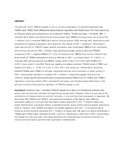| dc.description.abstract | The antiviral role of TRIM E3 ligases in vivo is not fully understood. To test the hypothesis that TRIM5α and TRIM22 have differential transcriptional regulation and distinct anti-HIV roles according to infection phase and compartment, we measured TRIM5α, TRIM22 and type 1 interferon (IFN-1)-inducible MxA levels in peripheral blood mononuclear cells (PBMCs) during primary and chronic HIV-1 infection, and in matched PBMCs and central nervous system (CNS)-derived cells. Associations with biomarkers of disease progression were explored. The impact of IFN-1, select pro-inflammatory cytokines and HIV on TRIM E3 ligase-specific expression was investigated. PBMCs from individuals with primary and chronic HIV-1 infection had significantly higher levels of MxA and TRIM22 compared to HIV-1 negative PBMCs (P < 0.05, all comparisons). PBMCs from chronic infection had lower levels of TRIM5α compared to primary infection or HIV-1 uninfected (both P = 0.0001). In matched CNS-derived samples and PBMCs, higher levels of MxA (P = 0.001) and TRIM5α (P = 0.0001) were noted in the CNS. There was negative correlation between TRIM22 levels in PBMC and plasma viral load (r = −0.40, P = 0.04). In vitro, IFN-1 and rarely pro-inflammatory cytokines induced TRIM5α and TRIM22 in cell type-dependent manner and knockdown of either protein in CD4+ lymphocytes resulted in increased HIV-1 infection. These data suggest that there are infection-phase specific and anatomically compartmentalized differences in TRIM5α and TRIM22 regulation involving primarily IFN-1 and specific cell types, and indicate subtle differences in the antiviral role and transcriptional regulation of TRIM E3 ligases in vivo.
Importance Interferon type I-inducible TRIM E3 ligases are a family of intracellular proteins with potent antiviral activities mediated through diverse mechanisms. However, little is known about the contribution of these proteins to antiviral immunity in vivo and how their expression is regulated. We show here that TRIM5α and TRIM22, two prominent members of the family, have different expression patterns in vivo and that expression pattern depends on HIV-1 infection status and phase. Furthermore, expression differs in peripheral blood versus central nervous system anatomical sites of infection. Only TRIM22 expression correlates negatively with HIV-1 viral load but gene silencing of both proteins enhances HIV-1 infection of target cells. We report on subtle differences in TRIM5α and TRIM22 gene induction by IFN-1 and pro-inflammatory cytokines in CD4+ lymphocytes, monocytes and neuronal cells. This study enhances our understanding of antiviral immunity by intrinsic antiviral factors and how their expression is determined. | en_US |

